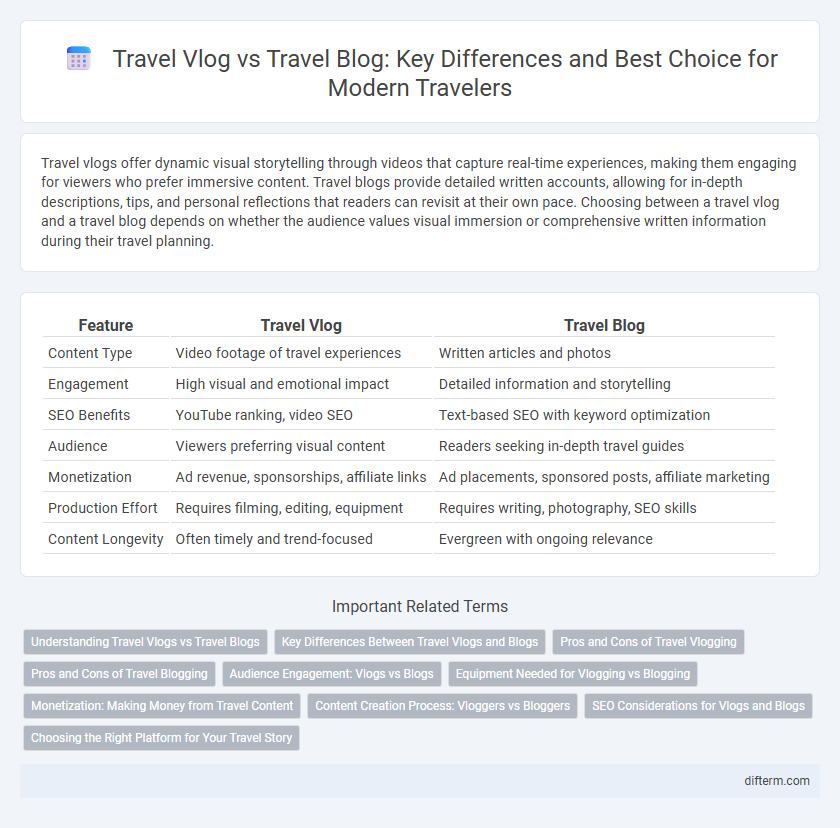Travel vlogs offer dynamic visual storytelling through videos that capture real-time experiences, making them engaging for viewers who prefer immersive content. Travel blogs provide detailed written accounts, allowing for in-depth descriptions, tips, and personal reflections that readers can revisit at their own pace. Choosing between a travel vlog and a travel blog depends on whether the audience values visual immersion or comprehensive written information during their travel planning.
Table of Comparison
| Feature | Travel Vlog | Travel Blog |
|---|---|---|
| Content Type | Video footage of travel experiences | Written articles and photos |
| Engagement | High visual and emotional impact | Detailed information and storytelling |
| SEO Benefits | YouTube ranking, video SEO | Text-based SEO with keyword optimization |
| Audience | Viewers preferring visual content | Readers seeking in-depth travel guides |
| Monetization | Ad revenue, sponsorships, affiliate links | Ad placements, sponsored posts, affiliate marketing |
| Production Effort | Requires filming, editing, equipment | Requires writing, photography, SEO skills |
| Content Longevity | Often timely and trend-focused | Evergreen with ongoing relevance |
Understanding Travel Vlogs vs Travel Blogs
Travel vlogs offer immersive visual storytelling through video content, capturing real-time experiences and emotions that engage viewers dynamically. In contrast, travel blogs provide detailed written narratives, offering comprehensive insights, tips, and reflections that are easy to reference and search. Both formats serve distinct purposes in travel content, with vlogs prioritizing immediacy and sensory impact, while blogs emphasize depth and information.
Key Differences Between Travel Vlogs and Blogs
Travel vlogs capture destinations through engaging visual storytelling and real-time experiences, utilizing video platforms like YouTube to attract audiences seeking immersive content. Travel blogs emphasize detailed written narratives, comprehensive guides, and high-quality photography, catering to readers looking for in-depth information and practical tips. The key difference lies in content format and audience engagement style, with vlogs prioritizing dynamic visuals and blogs offering extensive textual insights.
Pros and Cons of Travel Vlogging
Travel vlogging offers dynamic visual storytelling through videos that capture authentic experiences, making it easier to engage audiences and build a loyal following on platforms like YouTube and Instagram. However, the high cost of equipment, time-consuming editing process, and the pressure to maintain consistent content can be significant drawbacks for vloggers. In contrast, travel blogging requires less technical expertise and expenses but may struggle to achieve the same immediate emotional impact and viewer retention as video content.
Pros and Cons of Travel Blogging
Travel blogging offers detailed storytelling through written content, enabling in-depth descriptions, tips, and SEO benefits that attract search engine traffic. However, it requires strong writing skills and consistent updates to maintain audience engagement, which can be time-consuming and less visually dynamic compared to vlogging. The lack of immediate visual impact may limit emotional connection, but travel blogs excel in providing extensive information and long-form content perfect for travelers seeking comprehensive guidance.
Audience Engagement: Vlogs vs Blogs
Travel vlogs captivate audiences through dynamic visuals and authentic real-time experiences, fostering stronger emotional connections and higher viewer retention rates. Travel blogs engage readers with detailed narratives and SEO-optimized content, attracting niche audiences seeking in-depth information and practical tips. While vlogs excel in immediate sensory engagement, blogs offer searchable, comprehensive insights, making both essential for diverse audience engagement strategies.
Equipment Needed for Vlogging vs Blogging
Travel vlogging requires essential equipment such as a high-quality camera with image stabilization, an external microphone for clear audio, and portable lighting to enhance video clarity in various settings. In contrast, travel blogging primarily demands a reliable laptop or tablet for writing and editing, alongside a good quality digital camera or smartphone for capturing photos. While both forms benefit from a stable internet connection, vlogging equipment tends to be more tech-intensive and costly due to video production needs.
Monetization: Making Money from Travel Content
Travel vlogs generate higher engagement through dynamic video content, attracting more lucrative brand sponsorships and ad revenue on platforms like YouTube, making monetization more accessible and scalable. Travel blogs rely on SEO-driven organic traffic and affiliate marketing, leveraging detailed written guides and targeted keywords to generate steady income from ad placements and partnerships. Combining both formats can maximize earnings by diversifying income streams across visual and written travel content.
Content Creation Process: Vloggers vs Bloggers
Travel vloggers capture immersive experiences through dynamic video footage, emphasizing visual storytelling and real-time emotions, which requires skills in filming, editing, and on-camera presentation. Travel bloggers focus on detailed written content, blending descriptive narratives, SEO-driven keywords, and high-quality imagery, demanding expertise in writing, keyword research, and photo editing. The content creation process for vloggers often involves faster-paced production cycles, while bloggers invest more time in crafting polished articles optimized for search engines and readability.
SEO Considerations for Vlogs and Blogs
Travel vlogs benefit from high user engagement and visual appeal, making them ideal for platforms like YouTube that prioritize watch time and viewer interaction in SEO rankings. Travel blogs excel in keyword optimization and detailed content, allowing them to rank well on search engines by addressing specific search queries with in-depth information. Combining strategic keyword usage in blog content with video descriptions and transcriptions in vlogs enhances overall SEO performance and audience reach.
Choosing the Right Platform for Your Travel Story
Selecting between a travel vlog and travel blog depends on your storytelling style and audience engagement preferences. Travel vlogs offer dynamic visual content and real-time experiences via video platforms like YouTube, appealing to viewers who favor immersive, multimedia-rich narratives. Travel blogs provide in-depth, searchable written content with photos, ideal for readers seeking detailed travel tips, itineraries, and personal reflections accessible through SEO-optimized articles.
travel vlog vs travel blog Infographic

 difterm.com
difterm.com